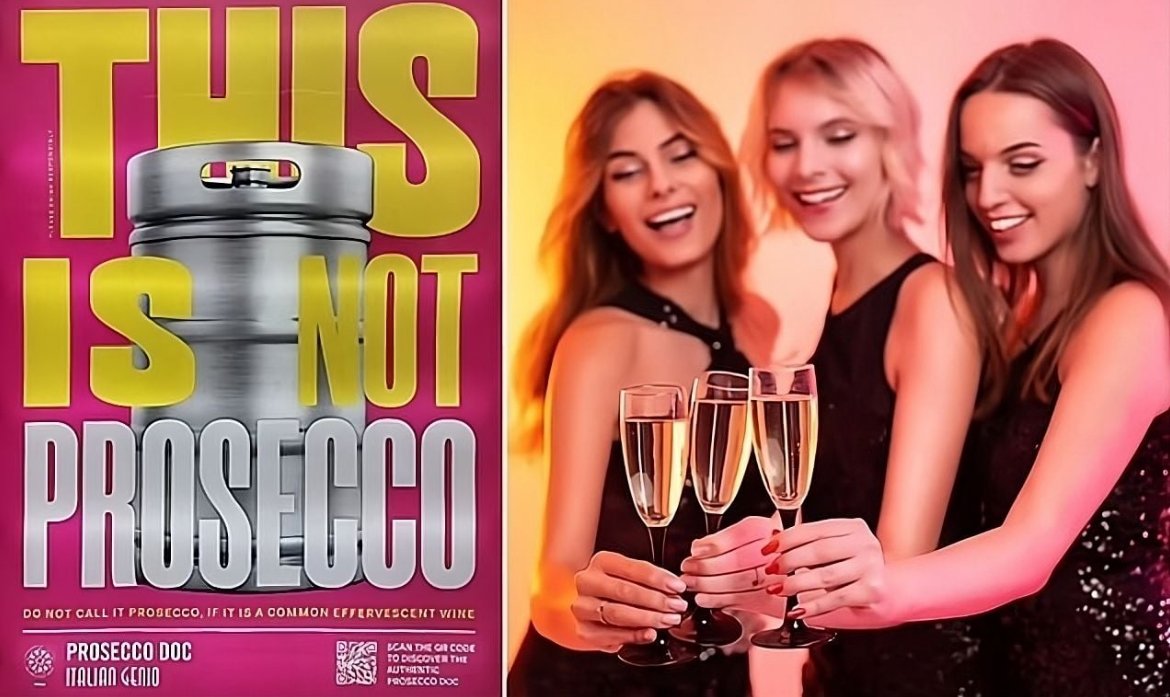Prosecco Police
Too successful? The battle for a brand name
<<<BACK TO LIQUIDzine
As Prosecco launches a battle for authenticity against copycat sparkling wines, we ask how can brands – and categories – defend themselves from wannabe attackers?
Hoovers. Sellotape. Even Google. What started out as distinct brand names eventually became catch-alls for the similar products they inspired. The proliferation of ‘me-too’ products that want in on trending, trendsetting goods is never accidental; it’s basic consumerism. But the danger for those in the hot heat of success is that their names, and good reputations with them, ultimately become meaningless.
And so we come to Prosecco, the world’s most popular sparkling wine. Not a brand name, but a protected term, Prosecco may have become a victim of its own success. Now producing over 700 million bottles a year, its makers are on the offensive. Appearing on billboards on the tube in recent months, in blazing yellow letters, are posters with an image of a keg, declaring “This is not Prosecco. Don’t call it Prosecco if it is a common effervescent wine.”
Ouch. That’s a pretty clear warning to consumers and copycats alike not to use the DOC (Controlled Designation of Origin) term as a catchall. It’s estimated the campaign will reach 15 million. Is Prosecco now so popular it’s become shorthand for generic fizzy wine?
The Consorzio di Tutela Prosecco DOC certainly seems to think so, and are keen to stop the free-for-all decline into unregulated production and sub-par quality products – such as carbonated kegged wine – taking its sales, sure, but also tarnishing its reputation.
Mark your territory
It’s not the first to mark its territory, and in doing so, educate consumers on what does and doesn’t constitute the ‘real thing’. In 2018, at the height of the boom, gin brand Hayman’s sounded the alarm for the category with its ‘Call Time on Fake Gin’ campaign.
It intended to “build awareness of the growing issue of products marketed as gins that have little to no juniper character”. James Hayman, fifth generation gin maker said: “There is broad agreement that gin needs to be better protected but there are many differing views on the form that such protection should take.” Though conversations among stakeholders took place, it looks like the campaign never made it to consumers. Did the slow down of gin sales ease the issue of substandard tagalongs? Or did stakeholders fail to align?
Shortcuts vs crafted authenticity
Another category where the debate over quality still rages is cider. Though we’ve come a long way from the late noughties where it seemed a new, saccharine flavoured cider brand launched weekly – from lemon drop to rhubarb and custard – the sweet appeal of apple, and pear, as a vehicle for novelty launches continues. Particularly aimed at new and emerging drinkers looking for easy-drinking, accessible or familiar flavour profile, the risk is that once tastes mature, they’ll abandon the category entirely in search of something ‘better quality’.
‘Cider is Wine’, the counter movement to heavily diluted ciders, doesn’t focus on doing down such products. Instead, it seeks to elevate the image of ‘crafted’ ciders by comparing apples with grapes, and cider with the quality and production cues consumers already understand from wine production. It calls for a new drinks category for 100% juice, not-from-concentrate ciders, perries, and fruit wines. And its dogged work seems to be gaining traction, at least from an industry, if not yet a broad consumer perspective.
The International Wine and Spirit Competition has backed it, and in 2023 the competition for cider, perry and fruit wine makers was open only to products containing freshly pressed and fermented fruit, or fruit must, and no concentrates, added water, flavourings or colourings.
Who wins?
How effective are such push backs? That depends entirely on who has the bigger reach; the sub par products, or the campaigns that either denounce them or raise-up authentic products instead. It also demands joined-up thinking from those involved; defences are only effective with consensus.
Consumers also need to feel incentivised to make the ‘right’ choice. Or in other words, they need to know what the discernible difference is between the real thing, and a copycat, and what’s the benefit to them of choosing ‘authenticity’? Brands or groups of producers need to show why they are the better option, such as Cider is Wine, rather than simply denouncing those that try to replicate them. Because actually, authenticity isn’t enough, it’s quality that matters.
That’s perhaps partly why the Prosecco campaign chose a keg as its campaign imagery, for its seeming low-quality cues, rather than directly call out any bottled product; legal issues aside, there are undoubtedly plenty. Which raises another point. Only recognised as a distinct wine producing region rather than just a grape name from 2009, Prosecco has borrowed the packaging cues from sparkling wine in general, which now unfortunately makes it a little hard to stand out as the real deal of its own genre from just a packaging point of view.
Good strategy, design and branding must work in unison to protect successful products or categories. Because as long as there are trending brands, they’ll be those looking to replicate them.


